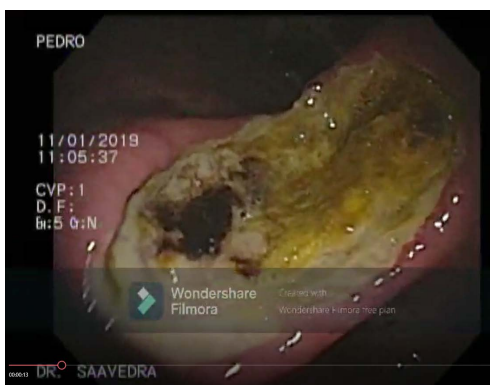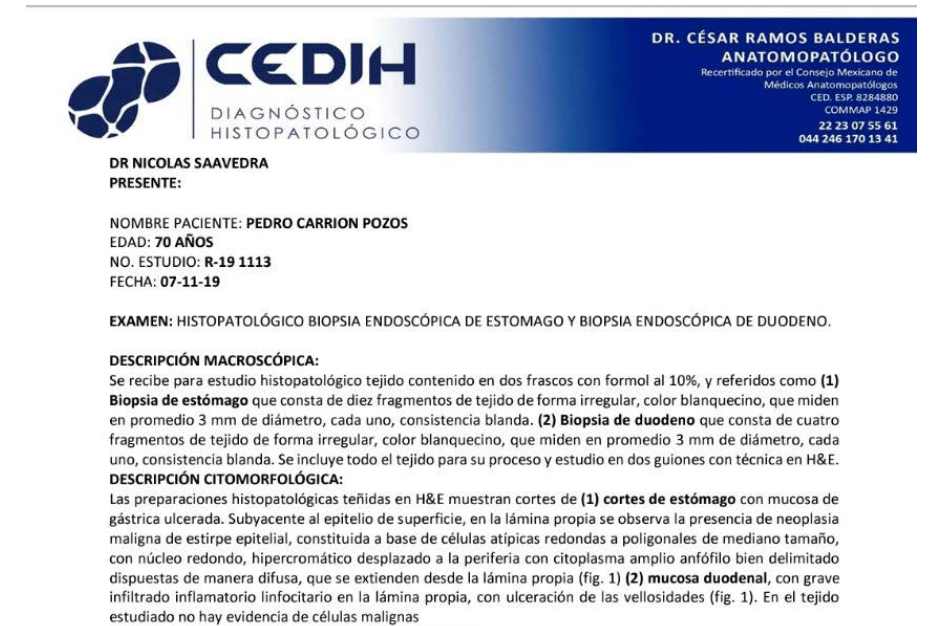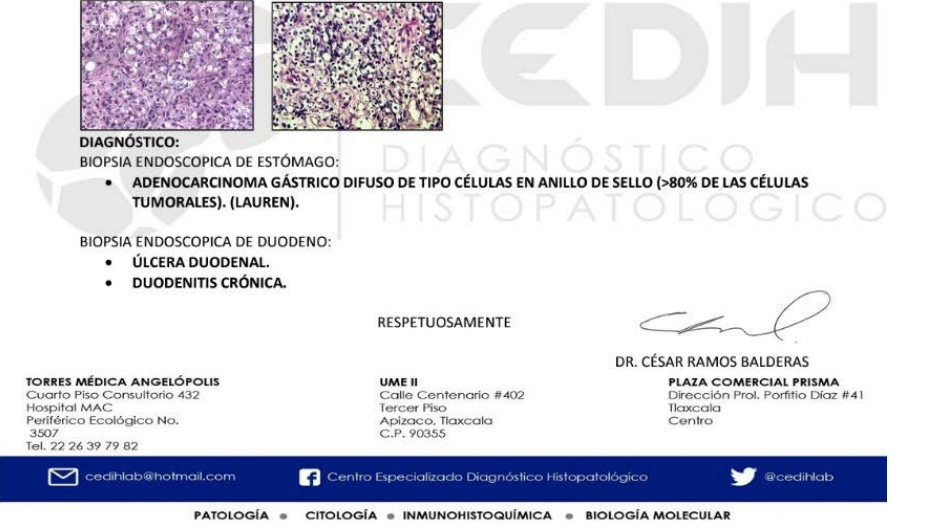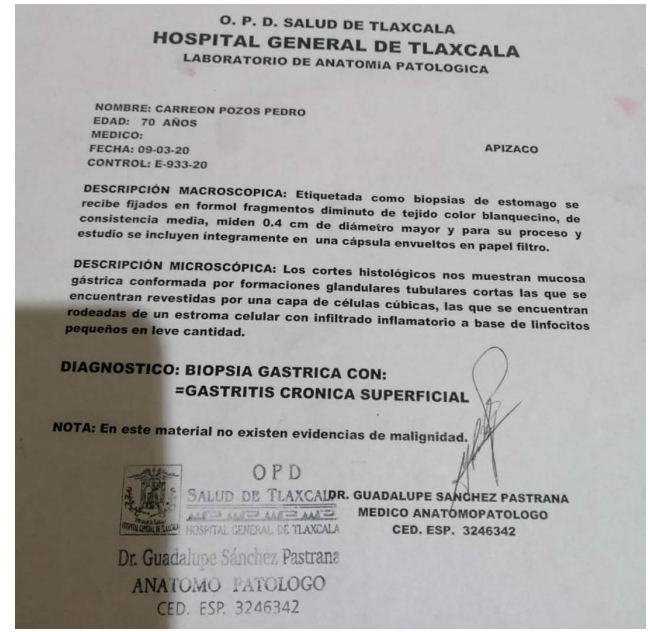Gastric Cancer and QIAPI, Case Report
Author'(s): Arturo Solís Herrera MD PhD1, and Nicolas Saavedra Rojas MD2
1Human Photosynthesis® Study Center, C. S. Aguascalientes 20000, México.
2Huamantla Medical Group. Guerrero Norte No 229, Esquina con, Abasolo Pte., 90500 Huamantla, Tlax.
*Correspondence:
Arturo Solís Herrera, Human Photosynthesis Study Center, C. S. Aguascalientes 20000, México.
Received: 28 Dec 2021 Accepted: 26 Jan 2022; Published: 30 Jan 2022
Citation: Herrera AS, Rojas NS. Gastric Cancer and QIAPI 1®, Case Report. Gastroint Hepatol Dig Dis. 2022; 5(1): 1-5.
Abstract
Despite significant therapeutic progress, gastric cancer remains among the deadliest forms of cancer encountered in clinical practice, and this remains true even in the context of declining incidence. Outcomes in advanced disease remain poor and therapy is rarely curative in this setting. Different therapies have developed in the hopes of altering nearly uniformly poor outcomes.
Keywords
Introduction
Gastric cancer (GC) is the second leading cause of cancer mortality and the fourth most diagnosed malignant diseases [1]. This year in the US alone, approximately 27,600 patients will be diagnosed and 11,010 will die from the disease [2]. GC is typically diagnosed in incurable stages, which contributes to its rank as the third leading cause of cancer death [3].
Our understanding of the molecular pathogenesis of GC is incomplete and marked by repeated failures [4]. Close to 95% of GCs are adenocarcinomas and within this classification, tumors can be broken down into intestinal or diffuse forms based on a histologic schema first proposed by Lauren in 1965 [5]. The intestinal type of GC is a well-differentiated tumor with gland structure that resembles normal colon [6].
Considering the diversity of mutations in GC, satisfactory results obtained from various target-specific therapies were expected, yet most of them were unsuccessful in controlled clinical trials [7].
The HER2 protein is a member of the ErbB family comprising 4 kinds of receptor tyrosine kinases (RTKs). The ErbB family of proteins includes transmembrane receptors composed of an intracellular region with a tyrosine kinase residue, an extracellular ligand-binding domain, and a single hydrophobic transmembrane segment. The HER2 protein plays a crucial role in cancer cell biology [8]. Despite a seemingly firm theoretical framework, and successful laboratory tests, its clinical efficacy has been rather nil.
A tumor cell is recognized by and is vulnerable to the host immune system. Classical reports of animal models have indicated that the immune system recognizes and eliminates tumor cells. However, via elimination, equilibrium, and finally escape, cancer cells become invisible to the host [9]. Because of defects in DNA mismatch repair genes, cancers with microsatellite instability (MSI) possess a high number of mutations, and express numerous surface antigens for presentation to immune cells [10].
Approximately 50% of GC cases are thought originate due to Helicobacter pylori infection [11]. H. pylori infection induces DNA methylation in tumor suppressor genes, and increases the levels of inflammation-related proteins, including tumor necrosis factor-alpha [12].
Clinical outcomes in GC patients may be improved via appropriately designed clinical studies. Appropriate target selection and patient inclusion criteria are essential; however, tumor heterogeneity of GC remains an obstacle even with fine targets serving as driver mutations.
However, the whole theory is based on glucose as an energy source. And failure is the rule. Well, despite careful studies, there seem to be factors that lead to the failure of clinical trials using treatments such as those noted above.
In this report, we describe our therapeutic results in gastric cancer (adenocarcinoma) based on pharmacologic modulation of the unsuspected ability of the human organism to take energy from water, dissociating it, as it happens in plants [13].
Case Report
Male patient, in the 7th decade of life, with poor appetite, weight loss, abdominal pain, vague discomfort in the abdomen, and sense of fullness in the upper abdomen after eating a small meal. Due to the persistence of the symptoms, and after some failed treatments, the patient went to consult with Dr. Nicolas Saavedra, gastroenterologist surgeon, who advised endoscopy as a diagnostic procedure.
The procedure was performed on 11/01/2019, and below is a photograph taken from the video recorded during the endoscopy.

Figure 1: The photograph shows frank malignant changes compatible with gastric adenocarcinoma. Transendoscopic biopsy was taken and histological study was performed.
According to the established protocols, the patient was advised to go to the oncology service, given the severity of the clinical picture. The patient did not accept the suggestion and opted for a remote consultation (online) with the Center for the Study of Human Photosynthesis.
Because we base our treatments on modulating the human body's unsuspected ability to dissociate the molecule from water, therapeutic approach that we started in 1998, and since one of the typical characteristics of cancer cells is aneuploidy, which for us reflects a generalized failure of the cell, which is compatible with marked alterations in energy supply.
We briefly mention that we identify the extraordinary ability of the human body to transform the power of sunlight into chemical energy, through the dissociation of water, like plants. Discerning an unknown but fundamental capacity of the human body was circumstantial, since we began an observational study in 1990, about the vessels that enter and leave through the optic nerve in humans, and the possible correlation with the three main causes of vision loss that are: macular degeneration, diabetic retinopathy, and glaucoma.
The study lasted 12 years and included fundus studies of six thousand patients. Until 2002, we understood that it was the same reaction as in plants. Therefore, plants and humans have the same origin: the dissociation of the molecule from water.
Gradually we observed that regardless of the name of the disease, the severity of it depended on the accuracy of the dissociation of water. For it is an amazingly accurate process that has not changed since the beginning of time. But accuracy is disturbed by polluted water, polluted air, agrochemicals, solvents, industrial waste, plastics, metals, etc.
When the very first reaction in biochemical logic of life is impaired, the cells, tissues, and organs tend to disorganize in an unpredictable way, and gastric cancer is an example that fit our experience about the delicate balance between mass and energy.
Once the balance and accuracy of water dissociation is restored through pharmacological treatment, body tissues shown a surprisingly capacity of recovery.
Our patient started the treatment with QIAPI 1®, an enhancer of water dissociation, developed at our laboratory that is administered in form of sublingual drops, at dose of three drops every hour during daytime.
The patient fill better, and three months later, the Patient went again to Dr. Saavedra, who suggested a second control endoscopy, which was performed on 02/27/2020. (Figure 3)
The tissue taken was sent to histopathological stud, we could not recover the lamellae, but the pathologist's report was as follows Figure 4.
Comment
The unsuspected ability of the human body to dissociate the water molecule establishes a before and after in biology. The fact that our organism can transform the power of rain into chemical energy, dissociating water, like plants, involves rewriting biochemistry in its entirety, because the prevailing dogma states that our body obtains energy and mass from glucose, which is not possible, because glucose is the universal precursor of any organic molecule in plants and animals, but it is not able to provide the energy that its own metabolism requires.
This implies reconsidering in its totality the biochemical logic of the eukaryotic cell, because now we know that energy can be captured directly from light, and the mass is structured from food. Glucose is an extraordinary molecule, and represents the most soluble molecule of carbohydrates, and in nature it is formed from CO2.


Figure 2: The histopathological study yielded results compatible with diffuse gastric adenocarcinoma of seal ring cell type, in more than 80%.

Figure 3: The improvement was surprising, and in a relatively short time (3 months), Dr. Saavedra was surprised by the improvement, as he had never seen anything like it, and from there he contacted us to ask for more information about our therapeutic approach. Finally, a biopsy was taken during the endoscopic procedure.

Figure 4: The histopathological report dated 03/09/2020, indicates findings compatible with chronic superficial gastritis.
The process of dissociating water is exact, astonishingly accurate and has not changed since the beginning of time. But it is disturbed in the presence of contaminated water, polluted air, pesticides, herbicides, fertilizers, metals, plastics, solvents, industrial waste, alcohol, anesthetics, emotional tension, etc.
When the dissociation process is altered, disturbed, in derangement, then the body tends to become disorganized, and sooner or later diseases appear. Throughout our observations, we can think that any disease begins with the imbalance of the dissociation of the water molecule, and depending on the age, weight, height, sex, and the various contaminants, then such and such disease will appear. Each person is unhinged in their own way.
Cancer is an example of extreme imbalance, that is, the balance between mass and energy is very much in the way; and when the fundamental energy source of the body is so affected, the failure in the biochemical and metabolic processes of the body spreads more and more, even affecting the genes, since these structures also require constant energy to replicate, to express themselves, to organize, even the genes, like any other structure of the body, also require energy even to conserve form.
For us, cancer is a clear example of widespread failure, which is typical of energy problems, which applies to any system. In cancer cells the disorder is repeated, because characteristically all cancer cells have aneuploidy, which implies that the lack of adequate energy inside the cell, and so severe, that even the genes are not being able to preserve the shape, the organization, the harmony that characterizes healthy living beings.
Conclusion
The discovery of the unsuspected ability of the human body to transform the power of light into chemical energy through the dissociation of the water molecule, such as plants, opens a new era in biology, and medicine is no exception.
Recognition
This work was funded by the Center for the Study of Human Photosynthesis, located in Aguascalientes, Mexico.
References
- Del Prete C, Muthiah A, Almhanna K. Does tumor profile in gastric and gastroesophageal (GE) junction cancer justify off- label use of targeted therapy?-a narrative review. Ann Transl 2020; 8: 1110.
- Stomach Cancer - Statistics [Internet]. Net. 2020 [cited 22 March 2020]. Available online: https://www.cancer.net/cancer-types/stomach-cancer/statisticsRetrievedSept112021.
- Hescheler DA, Plum PS, Zander T, et al. Identification of targeted therapy options for gastric adenocarcinoma by comprehensive analysis of genomic Gastric Cancer. 2020; 23: 627-638.
- Kelly CM, Janjigian YY. The genomics and therapeutics of HER2-positive gastric cancer-from trastuzumab and beyond. J Gastrointest 2016; 7: 750-762.
- Lauren The two histological main types of gastric carcinoma: diffuse and so-called intestinal-type carcinoma. An attempt at a histo-clinical classification. Acta Pathol Microbiol Scand. 1965; 64: 31-49.
- Shah MA, Khanin R, Tang L, et al. Molecular classification of gastric cancer: a new Clin Cancer Res. 2011; 17: 2693-701.
- Kim HJ, Oh SC. Novel Systemic Therapies for Advanced Gastric J Gastric Cancer. 2018; 18: 1-19.
- Gravalos C, Jimeno HER2 in gastric cancer: a new prognostic factor and a novel therapeutic target. Ann Oncol. 2008; 19: 1523-1529.
- Dunn GP, Old LJ, Schreiber The three Es of cancer immunoediting.Annu Rev Immunol. 2004; 22: 329-60.
- Arzimanoglou II, Gilbert F, Barber HR. Microsatellite instability in human solid Cancer. 1998; 82: 1808-1820.
- Forman D, Burley VJ. Gastric cancer: global pattern of the disease and an overview of environmental risk factors. Best Pract Res Clin Gastroenterol. 2006; 20: 633-649.
- Niwa T, Tsukamoto T, Toyoda T, et Inflammatory processes triggered by Helicobacter pylori infection cause aberrant DNA methylation in gastric epithelial cells. Cancer Res. 2010; 70: 1430-1440.
- Herrera, Arturo Esparza, M de CA, et al. Beyond mitochondria, what would be the energy source of the cell? Cent Nerv Syst Agents Med Chem. 2015; 15: 32-41.